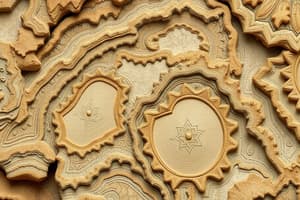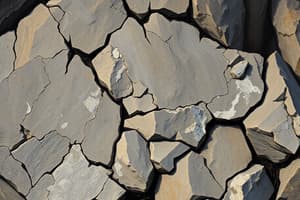Podcast
Questions and Answers
What characteristic is primarily associated with the minerals that predominantly compose metamorphic rocks?
What characteristic is primarily associated with the minerals that predominantly compose metamorphic rocks?
- They form exclusively in aqueous environments.
- They are mainly igneous in origin.
- They form at low temperatures and pressures.
- They form at high temperatures and pressures. (correct)
What process is responsible for the formation of minerals found in metamorphic rocks?
What process is responsible for the formation of minerals found in metamorphic rocks?
- Vulcanism
- Weathering
- Metamorphism (correct)
- Sedimentation
Which of the following conditions does NOT contribute to the formation of metamorphic rocks?
Which of the following conditions does NOT contribute to the formation of metamorphic rocks?
- High temperature
- Low temperature (correct)
- Tectonic activity
- High pressure
What is a key feature of the minerals formed under metamorphic conditions?
What is a key feature of the minerals formed under metamorphic conditions?
Which of the following describes the mineral composition typical of metamorphic rocks?
Which of the following describes the mineral composition typical of metamorphic rocks?
What role do index minerals play in geology?
What role do index minerals play in geology?
Which of the following characteristics can be determined through index minerals?
Which of the following characteristics can be determined through index minerals?
Why is the identification of index minerals important in metamorphic geology?
Why is the identification of index minerals important in metamorphic geology?
Index minerals are particularly useful in understanding which types of rocks?
Index minerals are particularly useful in understanding which types of rocks?
Which of the following statements about index minerals is incorrect?
Which of the following statements about index minerals is incorrect?
What process occurs when conglomerate rocks are composed of rock and mineral fragments undergo contact metamorphism?
What process occurs when conglomerate rocks are composed of rock and mineral fragments undergo contact metamorphism?
What is the resulting rock called after the recrystallization of a conglomerate under contact metamorphism?
What is the resulting rock called after the recrystallization of a conglomerate under contact metamorphism?
Which characteristic differentiates metaconglomerates from their parent materials?
Which characteristic differentiates metaconglomerates from their parent materials?
What evidence can be observed in metaconglomerates that signifies the process of metamorphism?
What evidence can be observed in metaconglomerates that signifies the process of metamorphism?
How do the physical characteristics of metaconglomerates compare to their parent material?
How do the physical characteristics of metaconglomerates compare to their parent material?
In what geological setting does contact metamorphism of conglomerate rocks primarily occur?
In what geological setting does contact metamorphism of conglomerate rocks primarily occur?
What effect does recrystallization have on the appearance of conglomerate rocks?
What effect does recrystallization have on the appearance of conglomerate rocks?
What is the term used to describe the type of texture mentioned in the content?
What is the term used to describe the type of texture mentioned in the content?
What is a common characteristic of the components in a metaconglomerate?
What is a common characteristic of the components in a metaconglomerate?
What results from the alignment of minerals in slaty texture?
What results from the alignment of minerals in slaty texture?
In slaty textures, how is the foliation physically manifested?
In slaty textures, how is the foliation physically manifested?
Which of the following best describes the nature of foliation in slaty rocks?
Which of the following best describes the nature of foliation in slaty rocks?
What effect does the foliation have on the rock's structural properties?
What effect does the foliation have on the rock's structural properties?
What causes minerals to align in slaty textures?
What causes minerals to align in slaty textures?
Which characteristic is NOT typically associated with slaty rocks?
Which characteristic is NOT typically associated with slaty rocks?
How does the tendency of slaty rocks to separate affect their usability in construction?
How does the tendency of slaty rocks to separate affect their usability in construction?
What does the term 'aphanitic' refer to in geology?
What does the term 'aphanitic' refer to in geology?
Which of the following best describes the process that leads to aphanitic texture?
Which of the following best describes the process that leads to aphanitic texture?
From which language does the term 'aphanitic' originate?
From which language does the term 'aphanitic' originate?
What is a characteristic of aphanitic rocks?
What is a characteristic of aphanitic rocks?
What does the process of rapid cooling affect in magma?
What does the process of rapid cooling affect in magma?
What tool is essential for distinguishing the mineral crystals in aphanitic rocks?
What tool is essential for distinguishing the mineral crystals in aphanitic rocks?
Which of these textures is NOT associated with rapidly cooled magma?
Which of these textures is NOT associated with rapidly cooled magma?
Which mineral characteristic is altered by rapid cooling in igneous rocks?
Which mineral characteristic is altered by rapid cooling in igneous rocks?
Why can aphanitic rocks be challenging to classify visually?
Why can aphanitic rocks be challenging to classify visually?
Aphanitic texture primarily indicates what type of cooling?
Aphanitic texture primarily indicates what type of cooling?
Flashcards are hidden until you start studying
Study Notes
Aphanitc Texture
- Aphanitc texture is a characteristic of rocks formed from rapidly cooled magma.
- The term "aphanitc" originates from the Greek word "aphaneros," meaning "invisible."
- Mineral crystals in aphanitc rocks are too small to be seen without a magnifying tool.
Metamorphic Rocks
- Metamorphic rocks are formed when existing rocks are transformed by heat and pressure.
- Some metamorphic rocks are primarily composed of minerals that form under high temperatures and pressures.
- Metamorphic rocks often exhibit a foliation, indicating the rock's tendency to separate along parallel planes.
- A type of foliated texture called "slaty" manifests as a distinct but not clearly defined foliation.
Slaty Cleavage
- Slaty cleavage is a foliated texture in metamorphic rocks.
- It results from the alignment of mineral crystals in the rock.
Metaconglomerate
- Metaconglomerate is a type of metamorphic rock formed from conglomerates.
- Conglomerates are rocks composed of rock and mineral fragments.
- During metamorphism, the smaller components of the conglomerate may recrystallize, creating a rock that resembles the original material but is denser and shows evidence of deformation.
Index Minerals
- Index minerals are crucial for identifying metamorphic rocks.
- They serve as indicators of the temperature and pressure conditions under which the rock formed.
Studying That Suits You
Use AI to generate personalized quizzes and flashcards to suit your learning preferences.




